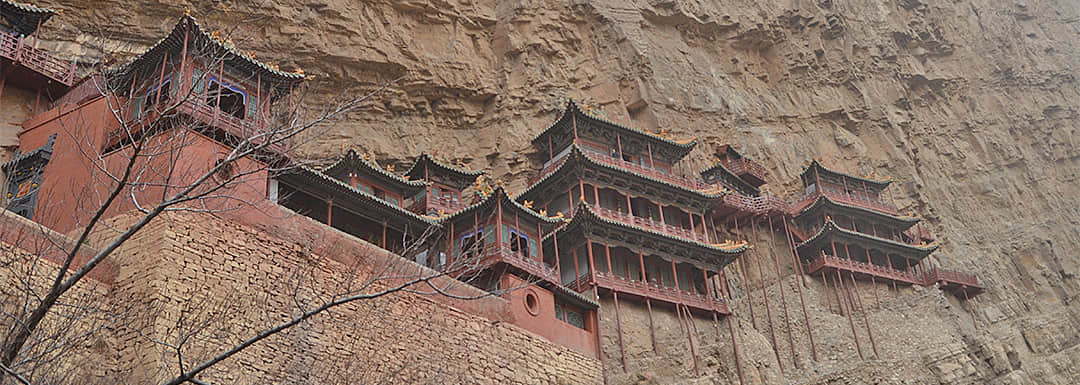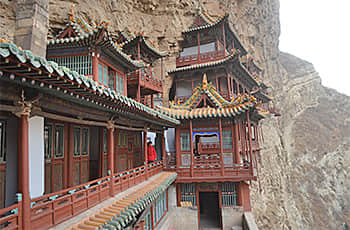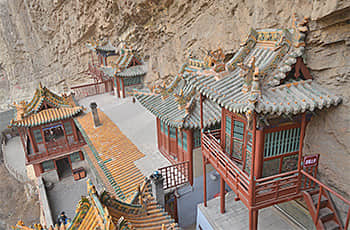Hanging Monastery

Hanging Monastery is located in the cliffs of Cuiping Peak on the west side of Jinlong Gorge in Hengshan Mountain, Hunyuan County, Datong, Shanxi Province. It was built in 491 CE, and is a unique Monastery that shows cultural traces of Buddhism, Taoism and Confucianism. A folk song goes "Hanging Monastery is suspended in the half with three-horsetails hanging mechanism". It overlooks the abyss and was called Hanging Pavilion. Later, the Hanging Pavilion got renamed as Monastery.
- Chinese name: 悬空寺 xuán kōng sì
- Suggested time: 1 day
- Ticket: RMB 130 per person
- Address: Wuyuan County, Datong, Shanxi Province
- Open hours: 8:30-17:30
- Best time to visit: Spring, summer and autumn
- How to get there: Take the public bus to Hunyuan County at Datong Bus Terminal or Xin Nan Bus Terminal. Then take a taxi to Hanging Monastery, which costs about RMB50.
Highlights of Hanging Monastery

The Hanging Monastery is in the layout of “one courtyard and two pavilions”, having a total length of about 32 meters and with 40 pavilions and halls.
The two majestic three-story high-rise buildings on the top of the mountain form a great pair. They are sitting on the cliff along the hillside. The three-sided corridors form a complete enclosure. The six buildings are well integrated with the suspended plank roads well connected.
South Building
The three-story South Building is about 8 meters long and about 4 meters wide. Chunyang Palace, San Guan Hall, Sanjiao Hall and Leiyin Hall are built in it. Chunyang Palace is also called Lvzu Monastery. It is mainly dedicated to Lu Dongbin, one of the Taoist Eight Immortals. Sangong Hall is the largest one in the entire building of the Hanging Monastery. Statues in the Monastery are clay sculptures from the Ming Dynasty. San Guan means the power that bring blessings, pardon and salvation. The 2 meter high clay sculpture is the largest statue in the Monastery. Other figures include maids and courtiers, General Tianpeng, General Turtle and General Snake. Leiyin Monastery is a Buddhist Monastery, located at the highest point of the South Building. Buddhists believe that when Buddha Sakyamuni raised the Dharma, the voice was as loud as thunder (Leiyin). So it was called Leiyin Monastery.
North Building 

The third floor of the North Building is about 7 meters long and about 4 meters wide. It includes Five Buddha Hall, Bodhisattva Hall and Sanjiao Hall. Five Buddha Hall is located on the lowest floor and is named after the Five Buddhas. Bodhisattva Monastery is in the middle layer of the building; Sanjiao Hall is a typical Monastery that reflects the "three religions in one” (a typical religious phenomenon in China), and is located at the top of the third part of the Hanging Monastery. Buddhism, Sakyamuni and Confucius sit in the same hall. Three religions together is extremely rare in monastery buildings across the country. The architecture of the Hanging Monastery resembles the harmony of the nations.
Changxian Bridge
Changxian Bridge is located between the South Building and the North Building. It is about 10 meters long. A pavilion is built on the bridge, in which there is a hall that enshrines Buddha. Changxia Bridge connects Buddhist Monasteries and buildings to form a fantastic, adventurous and wonderful landscape.
Drop us a line and we'll connect you with the top China expert in no time!